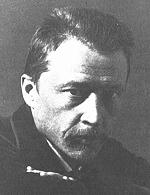
 (born
Slovenj Gradec, 13 March 1860; died Vienna, 22 February 1903).
(born
Slovenj Gradec, 13 March 1860; died Vienna, 22 February 1903).
He played the violin, piano and organ as a child and studied briefly
at the Vienna Conservatory (1875-7, meeting his idol Wagner) but, lacking
discipline and direction, he had to rely on friends and cultured benefactors
for help and introductions. His first important works, the songs of 1877-8,
arose from the effects of his sexual initiation and first romantic attachment.
Some are bright, others agonized, reflecting his depression and illness
from a syphilitic infection. Though in 1880 this cloud seemed to abate,
a pattern of cyclic mood swing and sporadic creativity was already established.
Holidays, studies of Wagner and radiant song settings alternated with personal
estrangements and a dark dramatic strain in his music. For three years
(1884-6), he wrote trenchant musical criticism for the Wiener Salonblatt,
siding with Wagner and against Brahms, meanwhile working on Penthesilea
(1883-5) and the d Minor Quartet (1878-84) and beginning a secret love
affair with Melanie Köchert. Compositional mastery and a sense of
purpose came only in the late 1880s, when he turned from subjectivity to
imaginative literature as a stimulus. In 1888 Eichendorff's poetry and
in particular Mörike's inspired a sudden flowering of song music that
in profusion and variety matched Schubert and Schumann. His acclaimed public
performances won new converts, and in February 1889 he finished the 51
songs of the Goethe songbook, in April 1890 the 44 Spanish songs. Publication
and critical recognition turned his thoughts to opera but from 1891 physical
exhaustion and depressive phases stemmed the flow of original music. In
1895 he composed his only completed opera, Der Corregidor, but it
was unsuccessful; in 1897 he composed his last songs and had the mental
breakdown that led to his terminal illness. 
Wolf's strength was the compression of large-scale forms and ideas - the essences of grand opera, tone poem and dramatic symphony - into song. Combining expressive techniques in the piano part with an independent vocal line, and using an array of rhythmic and harmonic devices to depict textual imagery, illustrate mood and create musical structure, he continued and extended the lied tradition of Schubert and Schumann. Yet he was original in his conception of the songbook as the larger dramatic form; each one seems to have been planned in advance to represent a poet or source. Folk music, nature studies, humorous songs and ballads peopled by soldiers, sailors, students or musicians recur in the German settings, while religious or erotic themes dominate the Spanish and Italian songbooks.